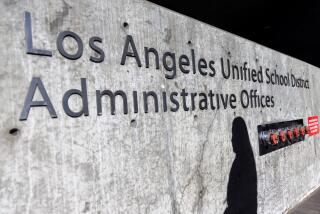Santa Ana Might Just Say No to DARE During School Hours
- Share via
Santa Ana school officials want to turn their antidrug DARE program into a voluntary after-school activity, a move likely to dramatically cut participation.
John Palacio, president of the Santa Ana Unified School District board, said trustees support the Drug Abuse Resistance Education program. But they want fifth- and sixth-grade students, who now attend hourlong DARE classes each week, to spend their entire school day on academics.
“DARE needs to be balanced between the academic priorities,” he said.
Founded jointly by Los Angeles police and schools 13 years ago, DARE has grown into the leading juvenile antidrug effort in the country, with programs in more than 5,000 communities.
But many experts say there are better ways to keep children from abusing drugs--such as providing more supervision and good role models and making sure kids are engaged in constructive activities. A study this year by the state legislative analyst’s office concluded that DARE didn’t keep children from using drugs. In fact, it found that suburban kids who took DARE were more likely than others to drink, smoke and take drugs.
“There’s a tremendous amount of money invested in DARE with very little evidence it works,” said James Alan Fox, dean of the Northeastern University College of Criminal Justice in Boston.
Despite the negative reports, California is giving DARE $1 million this year to expand the program into higher grade levels. This marks the first time since 1996 the state has funded DARE.
Under the program, law enforcement agencies send trained officers to elementary and junior high schools to teach them about drugs and gangs and how to resist peer pressure. The officers use guidebooks and teaching plans developed by the national DARE organization. The program serves about 14,000 students a year in Orange County.
Fox said it is often difficult for elected officials to come out against DARE. “If you’re a political leader and say you want to get rid of DARE, you’re labeled as someone who wants kids to take drugs,” he said.
Nevertheless, communities in Colorado, Florida, Texas, Massachusetts, Washington and elsewhere have said no to DARE in the past few years. Sometimes the problem is a lack of funding; other times there are concerns that the program is turning kids into snitches. Some conservatives have criticized the program as one that circumvents parental responsibility.
Charlie Parsons, the executive director of DARE America, said that about 75% of school districts in the country have embraced the program and that more schools are adding it than are dropping it.
In Orange County, the Buena Park School District cut DARE and Garden Grove Unified pulled the program from junior highs. On the other hand, Newport-Mesa Unified is considering expanding DARE into its high schools.
Santa Ana school administrators are recommending that trustees on Aug. 31 vote to move the DARE classes--now part of the regular curriculum--to after-school hours, when attendance would be voluntary.
Palacio said administrators will aggressively encourage students to attend the after-school DARE program, although it will compete with sports, music lessons, tutoring and play.
Sgt. Raul Luna of the Santa Ana Police Department criticized the proposal and said it could be the beginning of the end of the program in the city. “We feel that there is a need for gang and drug education, even though there have been some negative reports out there,” he said.
Santa Ana parent Wendy Tobiska agreed that the decision could end DARE in Santa Ana schools. “I don’t know how many kids will attend if they do it after school,” Tobiska said. “At least during school hours they have to do DARE.”
More to Read
Sign up for Essential California
The most important California stories and recommendations in your inbox every morning.
You may occasionally receive promotional content from the Los Angeles Times.














